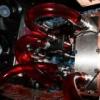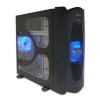Within about 6 seconds, however, everything abruptly shut down. No beeps, no post, no monitor display. Two seconds later, without touching anything, the computer powered up again. Five seconds later, off again. Two seconds later... In other words, an endless reboot cycle.
So I went through a checklist, trying to pinpoint the problem. I disconnected one hard drive. Same result. Then both drives, then the DVD drive, then the fan controller. I connected the CPU fan directly to the mobo's CPU_FAN header, thinking the board was shutting down as a safety precaution when it didn't detect a CPU fan. I switched the 2x4 pin ATX 12V power connector with a 2x2 pin connector, since my board and PSU support both. Each time I got the same exact reboot cycle.
Then I decided to completely disconnect the ATX_12V power cable to the mobo, leaving only the main 24-pin power connected. Surprisingly, the computer powered up and didn't shut down! The problem is, nothing else happened. No beeps and nothing displayed on the monitor, even after re-connecting all peripherals. All components seem to work fine. The fans (and fan controller) work, the DVD drive opens, the HDD's idle. But nothing actually happens. I can't enter BIOS since it doesn't to post, or at least, nothing shows up on the monitor. When I plug the ATX_12V power back into the mobo... reboot cycle.
So that's where I'm at now. I'm sure there's tons of info on the net about issues like this, but every homebuilt system is different. I'm hoping someone can point me in the right direction. I'm also really hoping it's not a faulty motherboard.
Here's the all-important spec list:
Gigabyte GA-EP35-DS3P
Corsair HX-520W
Intel E8400 Core2 Duo w/ Ultima-90 heatsink
Asus EN7300GT
4GB GSkill DDR2
320GB WD SATA HDD
640GB WD SATA HDD
Samsung S203N DVDRW
3 fans w/ Rheobus Sunbeam 5.25" controller
CoolerMaster CAC-T05 case


















 Sign In
Sign In Create Account
Create Account

